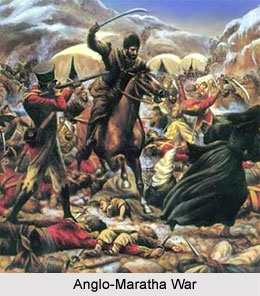 The Third Maratha War was the concluding and crucial conflict between the British East India Company and the Maratha Empire in India, which left the Company in total control of most of the country.
The Third Maratha War was the concluding and crucial conflict between the British East India Company and the Maratha Empire in India, which left the Company in total control of most of the country.
From the years of 1812 to 1816, the Company suffered an increasing number of raids by the Pindaris, or predatory robbers loosely associated with the Maratha armies. In May 1816, the Government of India established a subsidiary alliance with Nagpur to arrest the movement of Pindaris towards the south-east. The Company also forced Sindia into the treaty of Gwalior, binding him to assist in measures against the Pindaris. In June 1817, the British thrust a new treaty upon Peshwa Baji Rao II. Its terms required the Peshwa to renounce claims to leadership of the Maratha Confederacy, to pass all of his future correspondence through the British Resident, to cede to the Company the fort at Ahmednagar, and to accept responsibility for the murder of Gangadhar Shastri.
In the autumn of that year, two Company armies gathered, one in the north under Warren Hastings and another in the south led by Sir Thomas Hislop (1764-1843). The plan embraced the surrounding of an estimated 30,000 Pindaris with a total British force of 120,000. On 5th November, Baji Rao II, the Peshwa, attacked and burned the British Residency of Elphinstone at Poona (preset day Pune, Maharashtra). Elphinstone fled to a nearby British force of 3000 men. In the subsequent engagement fought at Kirkee that afternoon, the Marathas were defeated and the Peshwa was put to flight.
On 9th November, the British entered into an agreement with Amir Khan, a Pindaris leader who possessed much of Holkar`s territories. In consequence, he disbanded his troops, turned over to the British his artillery and thereafter became the Nawab of Tonk. During the days of 26th and 27th November, Appa Sahib (d.1840), Raja of Berar, attacked the Residency at Nagpur, which Richard Jenkins (1785-1853), British Resident, successfully fought off. With the arrival of a relieving force led by Brigadier-General John Doveton (1783-1857), Appa Sahib surrendered to Jenkins after the battle of Satibaldi.
On 21st December, British forces led by Malcolm and Hislop defeated Holkar`s army at Mahidpur in the only major engagement of the war. On 1st January 1818, at Koregaon, the Peshwa`s army of 28,000 men met unexpectedly with a Company force led by Captain Francis Staunton (c. 1779-1825). The Maratha attacks were beaten off and then withdrawn altogether from fear of approaching British reinforcements. In February, Munro commissioned as a brigadier-general, led a small force of irregular troops through southern Maratha Country capturing nine forts and securing the area for British Interests. On 2nd June, Peshwa Baji Rao II surrendered to Malcolm in Berar and was subsequently sent into exile in Benaras.
During the years of 1818-20, with the ostensible blessing of Warren Hastings, the firm of Palmer and Company provided the Nizam of Hyderabad a loan of sixty lakhs. What transpired was a transfer of an already existing debt of fifty-two lakhs at twenty-five percent interest to a debt of sixty lakhs at eighteen percent interest. Simultaneously, the Nizam was approached for a 200,000 pounds contribution towards the expenses of a public works project. In August 1818, Hastings removed the strict censorship measures placed on Anglo-Indian newspapers and journals for a milder set of policies.
The Peshwa was pensioned off and most of his territory was annexed to the Bombay Presidency. The Maharaja of Satara was re-established as ruler of a princely state until its annexation to Bombay state in 1848. The northern portion of the Nagpur Bhonsle territories, together with the Peshwa`s territories in Bundelkhand, were annexed to British India as the Saugor and Nerbudda Territories. The Maratha kingdoms of Indore, Gwalior, Nagpur and Jhansi became princely states. They were coerced to acknowledge British control.
The Third Anglo-Maratha War left the British in control of practically all of present-day India south of the Sutlej River.



















